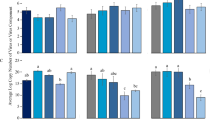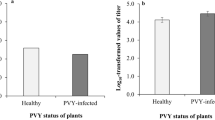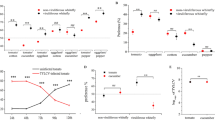Abstract
While virus-vector-crop interactions have received considerable attention, free-living plants growing in cultivated areas (‘weeds’) can also serve as viral reservoirs. Although weed-to-crop transmission is well documented, less is known about crop-to-weed transmission and how the interplay between the two plant groups affects disease dynamics. We explored reciprocal viral transmission of Tomato chlorosis virus (ToCV) between tomatoes and ToCV-susceptible weeds by Bemisia tabaci MED. A field survey assessed Bemisia density and ToCV titer in virus-susceptible weeds; a parallel experiment demonstrated that their removal reduced ToCV infection in tomatoes. Weeds growing far from greenhouses had lower rates of ToCV infection than greenhouse-adjacent ones, suggesting reciprocal crop-weed viral exchange. While Bemisia preferred tomato over weeds, vector density and viral infection of near-greenhouse populations of the dominant weed Amaranthus retroflexus increased following tomato harvest. ToCV infection altered volatile production in A. retroflexus; the Bemisia-attractant compound neophytadiene increased 26-fold in infected plants. Because temperatures increase over the growing season, we also explored the relationship between temperature, neophytadiene levels, and whitefly preference: plants grown at higher temperatures produced more neophytadiene and were preferred by whiteflies. We also assessed volatile production and jasmonic acid levels in control A. retroflexus versus those previously fed upon by either virus-free or viruliferous Bemisia. The largest shifts occurred in plants fed upon by viruliferous whiteflies, demonstrating that ToCV rather than Bemisia feeding explained the observed changes. Our results suggest that post-harvest viral transfer from crops to weeds may play an important role in driving disease outbreaks the following season and identify some simple but effective ways of reducing transmission into weedy plant species.







Similar content being viewed by others
Data availability
The d ata used to generate each figure in this paper will be available starting 9/23/23 at https://doi.org/10.6084/m9.figshare.23108354. This is the final depository.
References
Aregbesola OZ, Legg JP, Sigsgaard L, Lund OS, Rapisarda C (2019) Potential impact of climate change on whiteflies and implications for the spread of vectored viruses. J Pest Sci 92:381–392. https://doi.org/10.1007/s10340-018-1059-9
Bleeker PM et al (2009) The role of specific tomato volatiles in tomato-whitefly interaction. Plant Physiol 151:925–935. https://doi.org/10.1104/pp.109.142661
Byron M, Treadwell D, Dittmar P (2019) Weeds as reservoirs of plant pathogens affecting economically important crops. UF/IFAS Extension Service #HS1335
Cai J, Liu B, Ling P, Siu Q (2002) Analysis of free and bound volatiles by gas chromatography and gas chromatography–mass spectrometry in uncased and cased tobaccos. J Chromatogr A 947:267–275. https://doi.org/10.1016/S0021-9673(02)00015-8
Du J et al (2020) NSs, the silencing suppressor of tomato spotted wilt orthotospovirus, interferes with JA-regulated host terpenoids expression to attract Frankliniella occidentalis. Front Microbiol 11:590451. https://doi.org/10.3389/fmicb.2020.590451
Fanigliulo A, Pacella R, Comes S, Crescenzi A (2007) Three years survey of tomato yellow leaf curl Sardinia virus reservoir weed hosts in Southern Italy. Commun Agric Appl Biol Sci 72:1023–1028. PMID: 18396845
Fereres A et al (2016) Tomato infection by whitefly-transmitted circulative and non-circulative viruses induce contrasting changes in plant volatiles and vector behaviour. Viruses 8:225. https://doi.org/10.3390/v8080225
Fiallo-Olive E, Navas-Castillo J (2019) Tomato chlorosis virus, an emergent plant virus still expanding its geographical and host ranges. Mol Plant Pathol 20:1307–1320. https://doi.org/10.1111/mpp.12847
Gilbertson RL, Batuman O, Webster CG, Adkins S (2015) Role of the insect supervectors Bemisia tabaci and Frankliniella occidentalis in the emergence and global spread of plant viruses. Annu Rev Virol 2:67–93. https://doi.org/10.1146/annurev-virology-031413-085410
Hadjistylli M, Roderick GK, Brown JK (2016) Global population structure of a worldwide pest and virus vector: genetic diversity and population history of the Bemisia tabaci sibling species group. PLoS ONE 11:e0165105. https://doi.org/10.1371/journal.pone.0165105
Hogenhout SA, Ammar E-D, Whitfield AE, Redinbaugh MG (2008) Insect vector interactions with persistently transmitted viruses. Annu Rev Phytopathol 46:327–359. https://doi.org/10.1146/annurev.phyto.022508.092135
Hohn T (2007) Plant virus transmission from the insect point of view. Proc Natl Acad Sci USA 104:17905–17906. https://doi.org/10.1073/pnas.0709178104
Ingwell LL, Eigenbrode SD, Bosque-Pérez NA (2012) Plant viruses alter insect behavior to enhance their spread. Sci Rep 2:578. https://doi.org/10.1038/srep00578
Jones RAC (2020) Disease pandemics and major epidemics arising from new encounters between indigenous viruses and introduced crops. Viruses 12:1388. https://doi.org/10.3390/v12121388
Kazinczi G, Horváth J, Takács A, Gáborjányi R, Béres I (2004) Experimental and natural weed host-virus relations. Commun Agric Appl Biol Sci 69:53–60
Kil E-J et al (2015a) Identification of natural weed hosts of Tomato chlorosis virus in Korea by RT-PCR with root tissues. Eur J Plant Pathol 142:419–426. https://doi.org/10.1007/s10658-015-0622-y
Kil EJ et al (2015b) Tomato yellow leaf curl virus can overwinter in Stellaria aquatica, a winter-hardy TYLCV-reservoir weed. Plant Dis 99:588–592. https://doi.org/10.1094/PDIS-04-14-0352-RE
Kivrak I, Kivrak S, Harmandar M (2014) Free amino acid profiling in the giant puffball mushroom (Calvatia gigantea) using UPLC-MS/MS. Food Chem 158:88–92. https://doi.org/10.1016/j.foodchem.2014.02.108
Kumar P, Poehling HM (2006) UV-blocking plastic films and nets influence vectors and virus transmission on greenhouse tomatoes in the humid tropics. Environ Entomol 35:1069–1082. https://doi.org/10.1603/0046-225x-35.4.1069
Li P et al (2019) Plant begomoviruses subvert ubiquitination to suppress plant defenses against insect vectors. PLoS Pathog 15:e1007607. https://doi.org/10.1371/journal.ppat.1007607
Liu BM et al (2013) Multiple forms of vector manipulation by a plant-infecting virus: Bemisia tabaci and Tomato yellow curl leaf virus. J Virol 87:4929–4937
Liu B et al (2017) Plant defence negates pathogen manipulation of vector behaviour. Funct Ecol 31:1574–1581. https://doi.org/10.1111/1365-2435.12872
Liu Z, Zhang C, Ma L, Zhou X, Sun X, Ding J (2021) Elevated temperature decreases preferences of native herbivores to an invasive. Plant Entomol Gen 41:137–146. https://doi.org/10.1127/entomologia/2020/1050
Lu P et al (2010) Research progress on exotic invasive weed Amaranthus retroflexus. Chin J Ecol 29:1662–1670
Maluta NKP, Lopes JRS, Fiallo-Olivé E, Navas-Castillo J, Lourenção AL (2021) Foliar application of systemic insecticides disrupts feeding behavior of the whitefly Bemisia tabaci MEAM1 and the transmission of tomato chlorosis virus in potato plants. J Pest Sci 94:1265–1276. https://doi.org/10.1007/s10340-021-01333-y
Mauck KE, Chesnais Q, Shapiro LR (2018) Evolutionary determinants of host and vector manipulation by plant viruses. Adv Virus Res 101:189–250. https://doi.org/10.1016/bs.aivir.2018.02.007
Mauck KE, De Moraes CM, Mescher MC (2014) Biochemical and physiological mechanisms underlying effects of Cucumber mosaic virus on host-plant traits that mediate transmission by aphid vectors. Plant Cell Environ 37:1427–1439. https://doi.org/10.1111/pce.12249
Norris RF, Kogan M (2005) Ecology of interactions between weeds and arthropods. Annu Rev Entomol 50:479–503. https://doi.org/10.1146/annurev.ento.49.061802.123218
Northfield TD, Paini DR, Funderburk JE, Reitz SR (2008) Annual cycles of Frankliniella spp. (Thysanoptera: Thripidae) thrips abundance on North Florida uncultivated reproductive hosts: predicting possible sources of pest outbreaks. Ann Entomol Soc Am 101:769–778. https://doi.org/10.1603/0013-8746(2008)101[769:Acofst]2.0.Co;2
Online WW (2022) Shouguang climate weather averages. https://www.worldweatheronline.com/shouguang-weather-averages/shandong/cn.aspx. Accessed 07 July 22
Orfanidou CG, Dimitriou C, Papayiannis LC, Maliogka VI, Katis NI (2014) Epidemiology and genetic diversity of criniviruses associated with tomato yellows disease in Greece. Virus Res 186:120–129. https://doi.org/10.1016/j.virusres.2013.12.013
Orfanidou CG, Pappi PG, Efthimiou KE, Katis NI, Maliogka VI (2016) Transmission of Tomato chlorosis virus (ToCV) by Bemisia tabaci biotype Q and evaluation of four weed species as viral sources. Plant Dis 100:2043–2049. https://doi.org/10.1094/pdis-01-16-0054-re
Perier JD, Cremonez PSG, Champagne DE, Simmons AM, Riley DG, Reddy GVP (2022) Whiteflies at the intersection of polyphagy and insecticide resistance. Ann Entomol Soc Am. https://doi.org/10.1093/aesa/saac008
Preto CR, Sudarshana MR, Zalom FG (2018) Feeding and reproductive hosts of Spissistilus festinus (Say) (Hemiptera: Membracidae) found in Californian vineyards. J Econ Entomol 111:2531–2535. https://doi.org/10.1093/jee/toy236
Qin Z, Zhang JE, Jiang YP, Wei H, Wang FG, Lu XN, Clements D (2018) Invasion process and potential spread of Amaranthus retroflexus in China. Weed Res 58:57–67. https://doi.org/10.1111/wre.12282
SAS (2010) JMP user’s guide, version 9.0. SAS Institute Inc., Cary
Sarwar M, Aslam R (2020) New advances in insect vector biology and virus epidemiology. In: Awasthi LP (ed) Applied plant virology. Academic Press, Cambridge, pp 301–311. https://doi.org/10.1016/b978-0-12-818654-1.00023-2
Schweiger R, Heise AM, Persicke M, Muller C (2014) Interactions between the jasmonic and salicylic acid pathway modulate the plant metabolome and affect herbivores of different feeding types. Plant Cell Environ 37:1574–1585. https://doi.org/10.1111/pce.12257
Seyyedi SM, Moghaddam PR, Mahallati MN (2016) Weed competition periods affect grain yield and nutrient uptake of black seed (Nigella sativa L.). Hort Plant J 2:172–180. https://doi.org/10.1016/j.hpj.2016.08.005
Shi X et al (2014) Bemisia tabaci Q carrying tomato yellow leaf curl virus strongly suppresses host plant defenses. Sci Rep 4:5230. https://doi.org/10.1038/srep05230
Shi X et al (2017) Different effects of exogenous jasmonic acid on preference and performance of viruliferous Bemisia tabaci B and Q. Entomol Exp Appl 165:148–158. https://doi.org/10.1111/eea.12635
Shi X et al (2018a) Plants pre-infested with viruliferous MED/Q cryptic species promotes subsequent Bemisia tabaci infestation. Front Microbiol 9:1404. https://doi.org/10.3389/fmicb.2018.01404
Shi X et al (2018b) Transmission efficiency, preference and behavior of Bemisia tabaci MEAM1 and MED under the influence of tomato chlorosis virus. Front Plant Sci 8:2271. https://doi.org/10.3389/fpls.2017.02271
Shi X et al (2019) Variation in both host defense and prior herbivory can alter plant-vector-virus interactions. BMC Plant Biol 19:556. https://doi.org/10.1186/s12870-019-2178-z
Shi X, Zhang Z, Zhang C, Zhou X, Zhang D, Liu Y (2021) The molecular mechanism of efficient transmission of plant viruses in variable virus–vector–plant interactions. Hort Plant J 7:501–508. https://doi.org/10.1016/j.hpj.2021.04.006
Smith CM, Gedling CR, Wiebe KF, Cassone BJ (2017) A sweet story: Bean pod mottle virus transmission dynamics by Mexican bean beetles (Epilachna varivestis). Genome Biol Evol 9:714–725. https://doi.org/10.1093/gbe/evx033
Stafford CA, Walker GP, Ullman DE (2011) Infection with a plant virus modifies vector feeding behavior. Proc Natl Acad Sci USA 108:9350–9355. https://doi.org/10.1073/pnas.1100773108
Stafford CA, Walker GP, Ullman DE (2012) Hitching a ride: vector feeding and virus transmission. Commun Integr Biol 5:43–49
Su Q et al (2015) Manipulation of host quality and defense by a plant virus improves performance of whitefly vectors. J Econ Entomol 108:11–19. https://doi.org/10.1093/jee/tou012
Tang X et al (2017) Detection and epidemic dynamic of ToCV and CCYV with Bemisia tabaci and weed in Hainan of China. Virol J 14:169. https://doi.org/10.1186/s12985-017-0833-2
Trebicki P (2020) Climate change and plant virus epidemiology. Virus Res 286:198059. https://doi.org/10.1016/j.virusres.2020.198059
Wang RL et al (2019) Mikania micrantha wilt virus alters insect vector’s host preference to enhance its own spread. Viruses 11:336. https://doi.org/10.3390/v11040336
Wang L, Liu Y, Zhu X, Zhang Z, Huang X (2021) Identify potential allelochemicals from Humulus scandens (Lour.) Merr root extracts that induce allelopathy on Alternanthera philoxeroides (Mart.). Griseb Sci Rep 11:7068. https://doi.org/10.1038/s41598-021-86656-7
Wang Y, Zhang Y, Gao Z, Yang W (2018) Breeding for resistance to tomato bacterial diseases in China: challenges and prospects. Hort Plant J 4:193–207. https://doi.org/10.1016/j.hpj.2018.08.004
Wei K-k, Li J, Ding T-b, Liu T-x, Chu D (2019) Transmission characteristics of Tomato chlorosis virus (ToCV) by Bemisia tabaci MED and its effects on host preference of vector whitefly. J Integr Agric 18:2107–2114. https://doi.org/10.1016/s2095-3119(18)62080-5
Wintermantel WM (2010) Transmission Efficiency and epidemiology of criniviruses. In: Stansly PA, Naranjo SE (eds) Bemisia: bionomics and management of a global pest. Springer, Dordrecht, pp 319–331. https://doi.org/10.1007/978-90-481-2460-2_10
Wisler GC, Li RH, Liu H-Y, Lowry DS, Duffus JE (1998) Tomato chlorosis virus: a new whitefly-transmitted, phloem-limited, bipartite closterovirus of tomato. Phytopathology 88:402–409. https://doi.org/10.1094/phyto.1998.88.5.402
Yusoff SF, Haron FF, Tengku Muda Mohamed M, Asib N, Sakimin SZ, Abu Kassim F, Ismail SI (2020) Antifungal activity and phytochemical screening of Vernonia amygdalina extract against Botrytis cinerea causing gray mold disease on tomato fruits. Biology 9:286. https://doi.org/10.3390/biology9090286
Zhang PJ, Broekgaarden C, Zheng SJ, Snoeren TA, van Loon JJ, Gols R, Dicke M (2013) Jasmonate and ethylene signaling mediate whitefly-induced interference with indirect plant defense in Arabidopsis thaliana. New Phytol 197:1291–1299. https://doi.org/10.1111/nph.12106
Zhang Q, Song X, Bartels D (2018) Sugar metabolism in the desiccation tolerant grass Oropetium thomaeum in response to environmental stresses. Plant Sci 270:30–36. https://doi.org/10.1016/j.plantsci.2018.02.004
Acknowledgements
We thank Prof. Tao Zhou (China Agricultural University) for kindly providing the infectious cDNA clone of ToCV.
Funding
This work was supported by the National Natural Science Foundation of China (Nos. 32030088, 32072383, 31901854), and the Agriculture Research System of China (No. CARS-16-E-17, and CARS-23-D-02).
Author information
Authors and Affiliations
Corresponding authors
Ethics declarations
Competing interests
The authors declare that they have no competing interests.
Ethical approval
Not applicable.
Additional information
Communicated by Antonio Biondi.
Publisher's Note
Springer Nature remains neutral with regard to jurisdictional claims in published maps and institutional affiliations.
Supplementary Information
Below is the link to the electronic supplementary material.
Rights and permissions
About this article
Cite this article
Shi, Xb., Zhang, Z., Li, F. et al. Vector-mediated viral exchange between crops and weedy plants. J Pest Sci 97, 155–171 (2024). https://doi.org/10.1007/s10340-023-01644-2
Received:
Revised:
Accepted:
Published:
Issue Date:
DOI: https://doi.org/10.1007/s10340-023-01644-2




